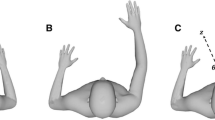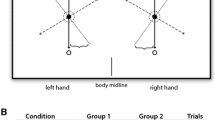Abstract
In right-handers, the ability to reproduce proprioceptive targets has been shown to be asymmetric, favoring the non-preferred left arm. The present study sought to determine whether a similar arm/hemisphere asymmetry exists for left-handers. Ten strong left-handed adults used the left or right arm to perform proprioceptive target matching tasks that varied in processing demands (i.e., need for memory, interhemispheric transfer) and target amplitude (20, 40°). Similar to right-handers, left-handed individuals had smaller total errors when matching with the non-preferred arm. This asymmetry was greatest in conditions with increased processing demands and larger amplitude targets. These results provide the first evidence to date of right arm/left hemisphere dominance for proprioceptive target matching in left-handers that is the “mirror image” of right-handers.

Similar content being viewed by others
References
Adamo DE, Martin BJ (2009) Position sense asymmetry. Exp Brain Res 192:87–95
Aimonetti JM, Morin D, Schmied A, Vedel JP, Pagni S. Somatosens Mot Res 16: 11-29
Boulinguez P, Velay JL, Nougier V (2001) Manual asymmetries in reaching movement control. II: Study of left-handers. Cortex 37:123–138
Chase C, Seidler R (2008) Degree of handedness affects intermanual transfer of learning. Exp Brain Res 190:317–328
Coren S, Porac C (1977) Fifty centuries of right-handedness: the historical record. Science 198:631–632
Dassonville P, Zhu XH, Uurbil K, Kim SG, Ashe J (1997) Functional activation in motor cortex reflects the direction and the degree of handedness. Proc Natl Acad Sci U S A 94:14015–14018
Elliott D, Roy E (1996) Manual asymmetries in motor performance. CRC Press, Boca Raton, pp 143–158
Gandevia SC, Refshauge KM, Collins DF (2002) Proprioception: peripheral inputs and perceptual interactions. Adv Exp Med Biol 508:61–68
Gilbert AN, Wysocki CJ (1992) Hand preference and age in the United States. Neuropsychologia 30:601–608
Goble DJ, Brown SH (2007) Task-dependent asymmetries in the utilization of proprioceptive feedback for goal-directed movement. Exp Brain Res 180:693–704
Goble DJ, Brown SH (2008a) Reply to Dr Derakhshan. J Neurophysiol 100:3459
Goble DJ, Brown SH (2008b) The biological and behavioral basis of upper limb asymmetries in sensorimotor performance. Neurosci Biobehav Rev 32:598–610
Goble DJ, Brown SH (2008c) Upper limb asymmetries in the matching of proprioceptive versus visual targets. J Neurophysiol 99(6):3063–3074
Goble DJ, Brown SH (2009) Dynamic proprioceptive target matching behavior in the upper limb: effects of speed, task difficulty and arm/hemisphere asymmetries. Behav Brain Res 200(1):7–14
Goble DJ, Lewis CA, Hurvitz EA, Brown SH (2005) Development of upper limb proprioceptive accuracy in children and adolescents. Hum Mov Sci 24:155–170
Goble DJ, Lewis CA, Brown SH (2006) Upper limb asymmetries in the utilization of proprioceptive feedback. Exp Brain Res 168:307–311
Goble DJ, Hurvitz EA, Brown SH (2009) Deficits in the ability to use proprioceptive feedback in children with hemiplegic cerebral palsy. Int J Rehabil Res (in press)
Gonzalez CL, Ganel T, Goodale MA (2006) Hemispheric specialization for the visual control of action is independent of handedness. J Neurophysiol 95:3496–3501
Gonzalez CL, Whitwell RL, Morrissey B, Ganel T, Goodale MA (2007) Left-handedness does not extend to visually guided precision grasping. Exp Brain Res 182:275–279
Goodale MA (1988) Hemispheric differences in motor control. Behav Brain Res 30:203–214
Grunewald G, Grunewald-Zuberbier E, Gotzinger R, Mewald J, Schuhmacher H (1987) Hemispheric asymmetry of feedback-related potentials in a positioning task: comparison of right- and left-handed subjects. Biol Psychol 24:209–223
Haggard P, Newman C, Blundell J, Andrew H (2000) The perceived position of the hand in space. Percept Psychophys 62:363–377
Henry FM (1974) Variable and constant performance errors within a group of individuals. J Mot Behav 6:149–154
Imanaka K, Abernethy B (1992a) Cognitive strategies and short-term memory for movement distance and location. Q J Exp Psychol 45:669–700
Imanaka K, Abernethy B (1992b) Interference between location and distance information in motor short-term memory: the respective roles of direct kinesthetic signals and abstract codes. J Mot Behav 24:274–280
Kim SG, Ashe J, Hendrich K, Ellermann JM, Merkle H, Ugurbil K, Georgopoulos AP (1993) Functional magnetic resonance imaging of motor cortex: hemispheric asymmetry and handedness. Science 261:615–617
Kurian G, Sharma NK, Santhakumari K (1989) Left-arm dominance in active positioning. Percept Mot Skills 68:1312–1314
Leonard G, Milner B (1991a) Contribution of the right frontal lobe to the encoding and recall of kinesthetic distance information. Neuropsychologia 29:47–58
Leonard G, Milner B (1991b) Recall of the end-position of examiner-defined arm movements by patients with frontal- or temporal-lobe lesions. Neuropsychologia 29:629–640
Liepmann H (1920) Die linke hemisphare und das handeln. Munch Med Wochenschr 49:2322–2326
Lutz K, Koeneke S, Wustenberg T, Jancke L (2005) Asymmetry of cortical activation during maximum and convenient tapping speed. Neurosci Lett 373:61–66
Marteniuk R (1973) Retention characteristics of motor short-term memory cues. J Mot Behav 5:249–259
Marteniuk R, Shields K, Campbell S (1972) Amplitude, position, timing and velocity as cues in reproduction of movement. Percept Mot Skills 35:51–58
Naito E, Roland PE, Grefkes C, Choi HJ, Eickhoff S, Geyer S, Zilles K, Ehrsson HH (2005) Dominance of the right hemisphere and role of area 2 in human kinesthesia. J Neurophysiol 93:1020–1034
Naito E, Nakashima T, Kito T, Aramaki Y, Okada T, Sadato N (2007) Human limb-specific and nonlimb-specific brain representations during kinesthetic illusory movements of the upper and lower extremities. Eur J Neurosci 25(11):3476–3487
Nishizawa S (1991) Different pattern of hemisphere specialization between identical kinesthetic spatial and weight discrimination tasks. Neuropsychologia 29:305–312
Oldfield RC (1971) The assessment and analysis of handedness: the Edinburgh Inventory. Neuropsychologia 9:97–113
Perelle IB, Ehrman L (2005) On the other hand. Behav Genet 35:343–350
Roy EA, MacKenzie C (1978) Handedness effects in kinesthetic spatial location judgements. Cortex 14:250–258
Sainburg RL (2005) Handedness: differential specializations for control of trajectory and position. Exerc Sport Sci Rev 33:206–213
Schmidt SL, Oliveira RM, Krahe TE, Filgueiras CC (2000) The effects of hand preference and gender on finger tapping performance asymmetry by the use of an infrared light measurement device. Neuropsychologia 38:529–534
Schutz RW, Roy EA (1973) Absolute error: the devil in disguise. J Mot Behav 5:141–153
Velay JL, Benoit-Dubrocard S (1999) Hemispheric asymmetry and interhemispheric transfer in reaching programming. Neuropsychologia 37:895–903
Wang J, Sainburg RL (2006) Interlimb transfer of visuomotor rotations depends on handedness. Exp Brain Res 175:223–230
Author information
Authors and Affiliations
Corresponding author
Rights and permissions
About this article
Cite this article
Goble, D.J., Noble, B.C. & Brown, S.H. Proprioceptive target matching asymmetries in left-handed individuals. Exp Brain Res 197, 403–408 (2009). https://doi.org/10.1007/s00221-009-1922-2
Received:
Accepted:
Published:
Issue Date:
DOI: https://doi.org/10.1007/s00221-009-1922-2




